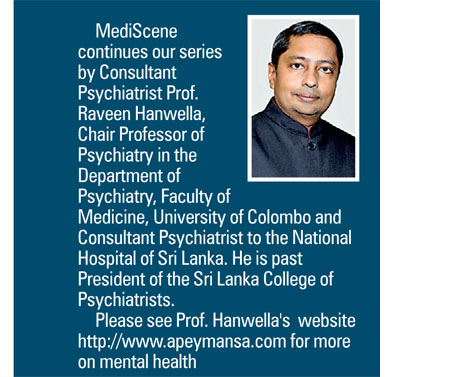It is a miracle
View(s):Prof. Raveen Hanwella discusses the ‘miracle question’, a key component of Solution Focused Therapy in psychology Impossible situations can become possible miracles. -Robert H. Schuller
You are wrestling with a seemingly insoluble problem. One day you go to sleep and a miracle happens and your problem goes away. When you wake up the next day how will you know that your problem has been solved?

Karen Carpenter died of heart failure due to excessive weight loss
Many years ago, when I was training in psychiatry in the UK, I went with my consultant to assess a 14-year-old girl who was suffering from anorexia nervosa. For those of you who are not medics, anorexia nervosa is a condition where a person drastically reduces his or her food intake due to an abnormal fear of getting fat. They may also exercise excessively, take laxatives and self-induce vomiting.
The exact cause for this strange condition is unknown but is thought to be due to a combination of genetic, psychological and social factors. Many famous persons have suffered from this condition including Victoria Beckham and Karen Carpenter. Karen later died of heart failure due to excessive weight loss. It is a potentially lethal condition and I was curious as to how my consultant was going to deal with the problem.
To my surprise, she did not ask any of the usual questions in a medical history. She inquired about all the things the girl used to enjoy before she became sick. She had been a bright and active girl and enjoyed sports and cycling. The consultant asked, “Would you like to be that person again?” and when she said ‘yes’, asked, “What would you need to do to get there and be the active and happy person you once were?” After that, she guided the conversation to the possibility that perhaps if she ate just a little more so that she might regain her strength she would get back to doing all the things she loved in the past.
That was my first introduction to the “miracle question.” The miracle question is a key component of Solution Focused Therapy developed by psychologists Steve de Shazer and Insoo Kim Berg. It is similar to ‘The Question,’ an intervention used by another famous therapist Alfred Adler. In Adler’s version, the question was “How would your life be different if you no longer had this problem?” No mention of a miracle here but again focusing on future possibilities and solutions rather than problems.
 Some have criticized the miracle question stating that the term miracle is a misnomer and gives false expectations of a sudden and even divine solution to problems. Steve de Shazer himself has admitted that perhaps the word miracle was too strong stating, “I think our initial mistake was to call it ‘the miracle question’ when it has never been just a simple question. Rather, its purpose was to shift the conversation quickly and easily into the future when the problems (that brought the client to therapy) were gone.”
Some have criticized the miracle question stating that the term miracle is a misnomer and gives false expectations of a sudden and even divine solution to problems. Steve de Shazer himself has admitted that perhaps the word miracle was too strong stating, “I think our initial mistake was to call it ‘the miracle question’ when it has never been just a simple question. Rather, its purpose was to shift the conversation quickly and easily into the future when the problems (that brought the client to therapy) were gone.”
But it is a catchy phrase that has lived on and become famous in therapy. Let us see how the miracle question can work to change your life. Let us say you want to lose 10 kg from your weight. The miracle question would be;“After you go to sleep tonight and wake up in the morning a miracle happens and you have lost 10kg of weight. How will you know that it has really happened?” Well you might say my dress won’t fit anymore, my trousers are falling down, I feel fit and have more energy now that I don’t have to carry all that extra baggage and people are commenting how good I look and they are asking me for the secret of my weight loss.
Hang on, you say “This is all imagination and miracles don’t happen anymore and I am still the same weight.” True, but now you have a vision of what can be and how it will be. Hold on to that and savour the feeling. If it seems worth your while, think how you might actually get there. There are three things you have to do; eat less, eat the correct food and exercise. You need to read or get advice from an expert source, develop a plan, and then put it into action. Perhaps you have tried to lose weight in the past but failed. You will need to analyse why you failed and do things differently this time.
Humans being are notorious for doing the same thing over and over even when it is not doing much good. Richard Bandler in his book Frogs into Princes tells the story of a scientist who tested the difference between humans and rats when they were asked to run a maze. At the end of the maze was a reward; cheese for the rats and five dollars for the humans. There wasn’t much of a difference though the humans, with time, reached their reward more quickly. The surprise came at the end when the researchers removed the reward. The rats soon stopped running but the humans never stopped looking for the dollars. Apparently, many years later,the humans were breaking into the lab at night looking for the prize!
In his book, Do One Thing Different, Bill O’ Hanlon says, “Insanity is doing the same thing over and over again, and expecting different results.” He tells the story of his friend Chris who had two young children and found herself getting less sleep than she needed. She usually woke up grouchy and snapping at her children and husband. One day after one of her blow-ups her husband remarked, “Did you get up on the wrong side of the bed this morning?” Thinking about it, Chris decided to roll over and get up from the other side of the bed and found that her mood was changed for the better, her morning irritability had disappeared.
We think that feelings cause behaviour, but in solution-oriented therapy, the premise is the opposite: actions create feelings, new actions create new feelings. Taking our example of trying to lose weight, first analyse the pattern of your eating and then change it. Try using a smaller plate so that you will serve less. Do not have a second helping. If you are right-handed, use your left hand. Use a small spoon. Eat standing up. Try something different, be creative but break the pattern. With big goals, you need to break it up into small steps. To be effective a person should exercise a minimum of three hours per week and not all of that on the same day. An hour three times a week would be ideal but for a person who has not exercised at all, it would be an impossible goal. But try five minutes a day or even a minute; that should be possible for most people. You might say “Five minutes of working out is not going to do anything for me.” True, but the purpose is to break your previous indolent pattern. After that, you can gradually increase the time to effective levels.
So, is there something really bothering you? Start with the miracle question. Think what needs to change to achieve the miracle. Then start taking the steps to get there, one step at a time. Then the miracle will happen, not overnight, not even in days, perhaps it may take years but be assured that you will change; if you want to.
To quote Carl Sandburg, “Though no one can go back and make a brand new start my friend, anyone can start from now and make a brand new end.”


